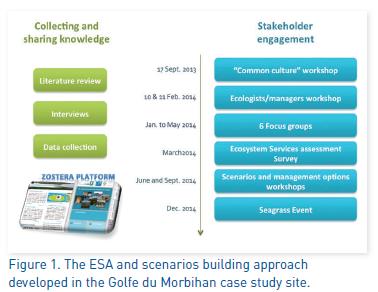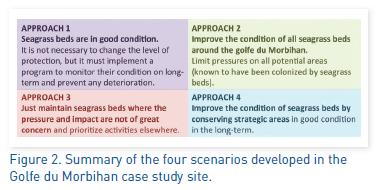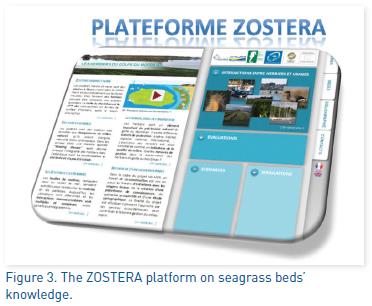The Place and the People we worked with
The Golfe du Morbihan (GDM) is located in south Brittany, in the Morbihan department. The case study area is delimited by the boundaries of the Regional Natural Park (RNP) of the Golfe du Morbihan. The area includes 30 municipalities and an associated marine area of 125 km connected to the Atlantic ocean by a narrow channel. The Golfe du Morbihan is famous for its high level of biodiversity, natural and cultural heritage, various habitats (mudflats, rocky foreshores, seagrass beds, etc.) and landscapes.
The VALMER Golfe du Morbihan case study team worked closely with the scientific team of the University of Brest and involved a wide range of local stakeholders concerned with the conservation of seagrass beds: elected members, professional representatives, NGos, recreational users, citizens, scientists, managers, etc. More than 100 stakeholders were involved during the project.
The Process
A broad and participative approach was developed in the Golfe du Morbihan case study site, combining an Ecosystem Services Assessment (ESA) of the services provided by seagrass beds with a scenario building exercise.
Seagrass beds are sensitive to pressures impacting environmental quality (e.g. lack of light, herbicides, trampling, grubbing, etc.). Due to their high ability to regenerate in a healthy environment, they are used as a water quality indicator for the European Water Framework Directive. In order to reconcile environmental conservation with the development of activities, the Regional Natural Park decided to experiment with the ecosystem services approach put forward in VALMER.
Ecosystem Services Assessment
The ESA was designed to:
1. Raise awareness of seagrass issues
2. Improve the management of seagrass beds through an integrated assessment
3. Identify management options to facilitate trade-offs
At the beginning of the project, the VALMER Golfe du Morbihan team chose to develop a multi-criteria assessment of seagrass beds based on social, economic and environmental criteria rather than a monetarised assessment. The VALMER team collected scientific and local knowledge to identify all the ecosystem services provided by seagrass beds in the Golfe du Morbihan (e.g. shelter for many species; food resource for birds feeding on their leaves (e.g. geese); improvement of sedimentation, etc.); and to better understand the natural and human factors that could affect the level of the ecosystem services provided by seagrass beds.
This assessment was done by combining several methods and tools (Figure 1):
- A scientific literature review
- Interviews
- Focus Groups
- A “choice experiment” survey
- A map analysis
- Conceptual modelling
- The development of a knowledge integration and sharing platform
The ESA in the Golfe du Morbihan was used to:
- Structure a systemic view of the coastal social and ecological system
- Propose a new management approach under a participatory process
- Discuss seagrass bed management with local stakeholders
Building Scenarios
In addition to the ESA, scenarios were developed with stakeholders to support the discussion of different possible management strategies (= scenarios). It was a good opportunity to collectively reflect on the implications of management options on the ecosystem service levels provided by seagrass beds. The purpose was to identify actions that could be implemented to improve today’s management of the seagrass beds in the Golfe. Using the ESA of seagrass beds of the Golfe, four scenarios (management strategies) were identified (Figure 2).
The Results
The results obtained in the Golfe du Morbihan are numerous and complementary. They are gathered in a knowledge platform on seagrass beds called ZOSTERA (Figure 3).
The ZoSTERA platform gathers:
- A seagrass beds atlas with 30 maps
- A scientific report on ecology, biology of seagrass beds and their interactions with human activities
- Five leaflets that summarize the results obtained during the project
- A comic strip on seagrass beds, the ecosystem services they offer, and the natural and human pressures they face
- A conceptual model of interactions between seagrass beds and human activities
- The presentations made at the ‘seagrass event’ (4th Dec. 2014)
These results and materials will be disseminated broadly by mail, in printed format and digital documents and made available for download on the Regional Natural Park website.
Implications for Governance
The results obtained in the VALMER project will complete the objectives Natura 2000 Document in the Golfe. We hope that they will also provide new ideas and information that can be used during the reviewing of the Plan for Sea Development (a maritime planning document) in 2016, in order to improve management of seagrass beds without unnecessary constraints on activities.
For more information on the Golfe du Morbihan case study please contact Juliette Herry: juliette.herry@golfe-morbihan.fr

 English
English  Français
Français 














Comments are currently closed for this case study!